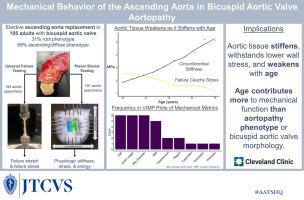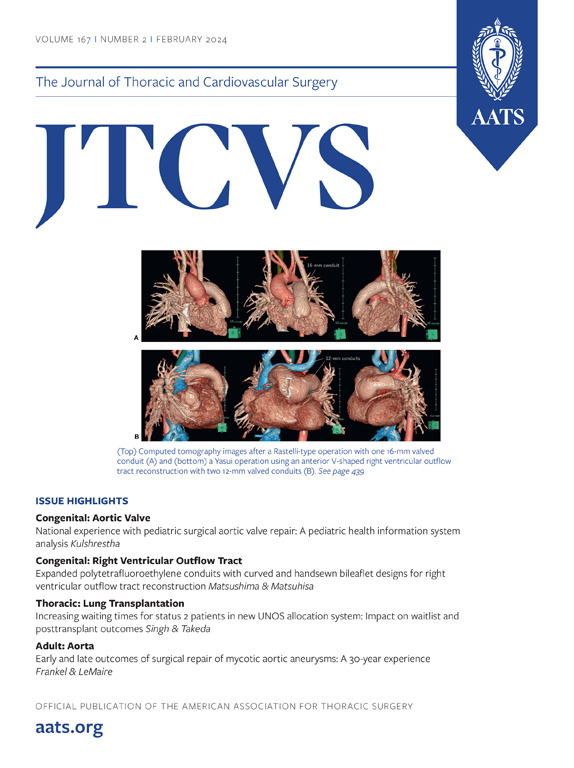Age is superior to aortopathy phenotype as a predictor of aortic mechanics in patients with bicuspid valve
IF 4.9
1区 医学
Q1 CARDIAC & CARDIOVASCULAR SYSTEMS
Journal of Thoracic and Cardiovascular Surgery
Pub Date : 2025-02-01
DOI:10.1016/j.jtcvs.2023.12.018
引用次数: 0
Abstract
Objectives
Bicuspid aortic valve (BAV) aortopathy is defined by 3 phenotypes—root, ascending, and diffuse—based on region of maximal aortic dilation. We sought to determine the association between aortic mechanical behavior and aortopathy phenotype versus other clinical variables.
Methods
From August 1, 2016, to March 1, 2023, 375 aortic specimens were collected from 105 patients undergoing elective ascending aortic aneurysm repair for BAV aortopathy. Planar biaxial data (191 specimens) informed constitutive descriptors of the arterial wall that were combined with in vivo geometry and hemodynamics to predict stiffness, stress, and energy density under physiologic loads. Uniaxial testing (184 specimens) evaluated failure stretch and failure Cauchy stress. Boosting regression was implemented to model the association between clinical variables and mechanical metrics.
Results
There were no significant differences in mechanical metrics between the root phenotype (N = 33, 31%) and ascending/diffuse phenotypes (N = 72, 69%). Biaxial testing demonstrated older age was associated with increased circumferential stiffness, decreased stress, and decreased energy density. On uniaxial testing, longitudinally versus circumferentially oriented specimens failed at significantly lower Cauchy stress (50th [15th, 85th percentiles]: 1.0 [0.7, 1.6] MPa vs 1.9 [1.3, 3.1] MPa; P < .001). Age was associated with decreased failure stretch and stress. Elongated ascending aortas were also associated with decreased failure stress.
Conclusions
Aortic mechanical function under physiologic and failure conditions in BAV aortopathy is robustly associated with age and poorly associated with aortopathy phenotype. Data suggesting that the root phenotype of BAV aortopathy portends worse outcomes are unlikely to be related to aberrant, phenotype-specific tissue mechanics.

年龄比大动脉病变表型更能预测双腔瓣患者的主动脉力学状况
目的根据主动脉最大扩张区域,将主动脉瓣二尖瓣(BAV)主动脉病变定义为三种表型--根型、升型和弥漫型。我们试图确定主动脉机械性能和主动脉病变表型与其他临床变量之间的关联。方法从 2016 年 1 月 8 日至 2022 年 1 月 3 日,我们从 105 名因 BAV 主动脉病变而接受择期升主动脉瘤修复术的患者身上收集了 375 份主动脉标本。平面双轴数据(191 个标本)提供了动脉壁的构成描述,这些描述与活体几何和血流动力学相结合,可预测生理负荷下的刚度、应力和能量密度。单轴测试(184 个样本)评估了失效拉伸和失效考氏应力。结果根表型(样本数=33,31%)和上升/弥漫表型(样本数=72,69%)的机械指标无明显差异。双轴测试表明,年龄越大,周向刚度越大,应力越小,能量密度越小。在单轴测试中,纵向与周向试样在明显较低的考氏应力(第 50 个百分位数[第 15 个百分位数,第 85 个百分位数]:1.0 [0.7, 1.6] MPa vs. 1.9 [1.3, 3.1] MPa; P<0.001)。年龄与失效拉伸和应力的降低有关。结论BAV主动脉病变在生理和衰竭条件下的主动脉机械功能与年龄密切相关,而与主动脉病变表型关系不大。有数据表明,BAV 主动脉病变的根部表型预示着较差的预后,这不太可能与表型特异的异常组织力学有关。
本文章由计算机程序翻译,如有差异,请以英文原文为准。
求助全文
约1分钟内获得全文
求助全文
来源期刊
CiteScore
11.20
自引率
10.00%
发文量
1079
审稿时长
68 days
期刊介绍:
The Journal of Thoracic and Cardiovascular Surgery presents original, peer-reviewed articles on diseases of the heart, great vessels, lungs and thorax with emphasis on surgical interventions. An official publication of The American Association for Thoracic Surgery and The Western Thoracic Surgical Association, the Journal focuses on techniques and developments in acquired cardiac surgery, congenital cardiac repair, thoracic procedures, heart and lung transplantation, mechanical circulatory support and other procedures.

 求助内容:
求助内容: 应助结果提醒方式:
应助结果提醒方式:


